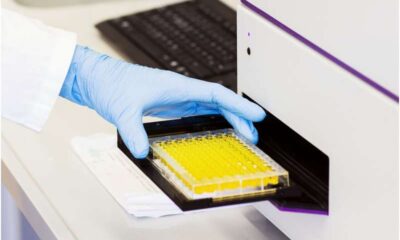Health
Pea Protein Hydrolysates Show Different Effects on Satiety

Researchers from the Leibniz Institute for Food Systems Biology at the Technical University of Munich have discovered that different hydrolysates derived from pea protein affect satiety in distinct ways. Published in the journal Molecular Nutrition & Food Research, the study provides insights that could inform the development of plant-based foods aimed at aiding weight management.
Protein hydrolysates, formed by breaking down proteins into smaller fragments and amino acids, are increasingly utilized in the production of plant-based products. With rising demand for these protein sources, which require less energy, water, and land compared to animal products, understanding their effects on satiety is crucial.
A notable challenge associated with protein hydrolysates is their often bitter taste, which can deter consumers. According to Katrin Gradl, the first author of the study, this bitterness is attributed to specific peptides and free amino acids. Previous research has suggested that these bitter compounds may influence feelings of fullness, potentially by slowing gastric emptying or enhancing the release of satiety hormones.
Study Design and Findings
The research team, led by Veronika Somoza, conducted a pilot study involving 19 overweight men with a body mass index (BMI) ranging from 25 to 30 kg/m². Participants were administered one of two different pea protein hydrolysates—each with varying bitterness and degrees of hydrolysis—before a test breakfast.
Hydrolysate H1 was characterized as less bitter and more extensively hydrolyzed (35% degree of hydrolysis), while H2 was more bitter and less hydrolyzed (23% degree of hydrolysis), making it harder to digest. Participants consumed as much as they desired during breakfast, allowing researchers to measure energy intake.
Results revealed that those who ingested the bitter, less hydrolyzed H2 experienced delayed gastric emptying, consuming an average of approximately 126 kilocalories less at breakfast. In contrast, H1 significantly reduced levels of ghrelin and DPP4 in the blood but did not affect short-term energy intake. Reduced levels of ghrelin, which signals hunger, and lower DPP4 concentrations, which prolong the activity of satiety hormones, indicate differing mechanisms of action for the two hydrolysates.
“Our results show that both hydrolysates influence the feeling of satiety in different ways,” Somoza explained. “Hydrolysate H2 quickly made the subjects feel full, so they ate less. Hydrolysate H1 had a delayed effect and presumably promotes a longer-lasting feeling of satiety between meals.”
Implications for Nutrition and Food Development
The findings underscore the importance of both bitterness and the degree of hydrolysis in shaping feelings of fullness. This could be pivotal for developing functional foods that naturally assist in reducing energy intake.
The BMI scale used in the study categorizes individuals as follows: underweight (BMI below 18.5), normal weight (18.5 to 24.9), overweight (25.0 to 29.9), and obese (30.0 and above). These classifications are widely used to assess body weight relative to height and can vary based on factors such as age, gender, and muscle mass.
Currently, the pea protein hydrolysates available on the market are partial hydrolysates, created through enzymatic or chemical processes that do not fully break down proteins. The degree of hydrolysis quantifies the extent of protein breakdown, indicating how many peptide bonds have been cleaved.
This research sets the stage for further exploration into the potential of plant-based proteins in nutrition, specifically their role in weight management strategies. More information on this study can be found in the article by Katrin Gradl et al., titled “Randomized Controlled Trial: Effects of a Bitter‐Tasting Pea Protein Hydrolysate Intervention With Low Degree of Hydrolyzation on Energy Intake in Moderately Overweight Male Subjects,” published on March 15, 2025.
-

 Technology4 months ago
Technology4 months agoDiscover the Top 10 Calorie Counting Apps of 2025
-

 Health2 months ago
Health2 months agoBella Hadid Shares Health Update After Treatment for Lyme Disease
-

 Health3 months ago
Health3 months agoErin Bates Shares Recovery Update Following Sepsis Complications
-

 Technology3 weeks ago
Technology3 weeks agoDiscover 2025’s Top GPUs for Exceptional 4K Gaming Performance
-

 Technology4 months ago
Technology4 months agoDiscover How to Reverse Image Search Using ChatGPT Effortlessly
-

 Technology2 months ago
Technology2 months agoElectric Moto Influencer Surronster Arrested in Tijuana
-

 Technology4 months ago
Technology4 months agoMeta Initiates $60B AI Data Center Expansion, Starting in Ohio
-

 Technology4 months ago
Technology4 months agoRecovering a Suspended TikTok Account: A Step-by-Step Guide
-

 Health4 months ago
Health4 months agoTested: Rab Firewall Mountain Jacket Survives Harsh Conditions
-

 Lifestyle4 months ago
Lifestyle4 months agoBelton Family Reunites After Daughter Survives Hill Country Floods
-

 Technology3 months ago
Technology3 months agoUncovering the Top Five Most Challenging Motorcycles to Ride
-

 Technology4 weeks ago
Technology4 weeks agoDiscover the Best Wireless Earbuds for Every Lifestyle











